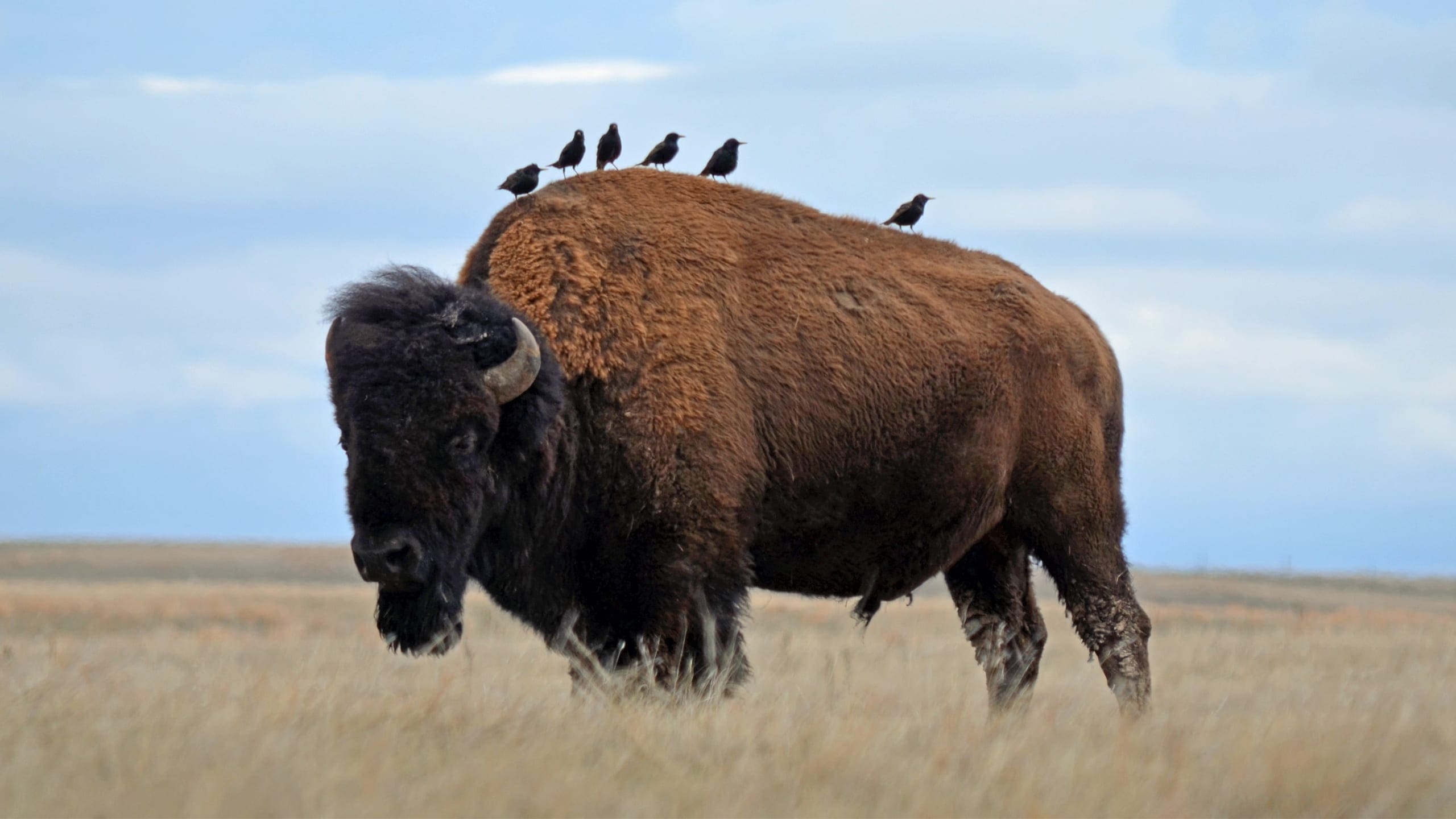About Wind Cave National Park
The Black Hills region that includes Wind Cave has had a complex and changing history of human occupation that extends back centuries and many generations to prehistoric times.
The Paleoindian period in the Great Plains around 7500 to 10,000 BP is associated with lush grasslands, large herds, and mineral resources that naturally drew people to the region, including areas of the Black Hills. The later archaic period coincided with a warmer, dryer climate that likely caused the extinction of bison antiquus, the ancient relative of modern bison, and moved human populations to the cooler, higher locations of the Black Hills’ forests and meadows. Adapting to new territorial ranges, the human population continued to hunt bison in a specialized, communal fashion, but also hunted smaller game, such as pronghorn, elk, and deer. Shelters in the lower hills provided habitation for thousands of years during this time.
The Prehistoric era brought tribes of the northwestern plains use of horses and the bow and arrow by around 250 CE. Bison remained the focus of large-scale hunting as people migrated in the region to the hills, river banks, canyons, and open plains. Tribes frequently met one another in peace, collaboration, competition, and conflict as these diverse groups moved throughout the region.
By the 16th century, the Black Hills were not an exclusive homeland to any one tribe, but rather were habited by different groups with different cultural traditions and practices. Although the Black Hills has traces of habitation of more than 10 different tribal nations, the Lakotas and Cheyennes are the tribes with the most well-documented, ongoing historical and cultural relationship to the Black Hills for the past 200 years. The Arapahos arrived to the area sometime in the early 1700s, and many other tribes have historical and cultural relations with the Black Hills as well.
Oral traditions reveal that Wind Cave is one of the most sacred and culturally significant areas in the Black Hills for the Lakotas and Cheyennes. The Lakotas have long identified Wind Cave as a site of genesis where the first humans emerged from the subterranean depths of the cave. The park land above the cave also has long been a place of important cultural connection for the Lakotas, who believe that the site is the home of the buffalo nation and carries cosmological traditions about the relationships between the cave, bison, regeneration, and the wind. The Lakotas and Cheyennes both continue to hold important cultural relationships between humans, animals, and topographical features in the Black Hills, including Wind Cave.
In the last half of the late 19th century, large numbers of Lakotas, Cheyennes, and Arapahos moved within the Black Hills and surrounding plains for better grazing lands, more productive bison hunting, and to find sanctuary from the increasing encroachment of U.S. military troops, prospectors, and settlers in the Black Hills by the 1870s. Many of the region’s attributes that had sustained the tribes for thousands of years—the mild climate, grasses, rich plant communities, mineral waters, timber supply, and abundant game—had attracted increasing numbers of white, non-Indian settlers to the Black Hills in the late 1800s.
Although American Indian tribes of the Black Hills have known about the opening to Wind Cave for thousands of years, two settlers, Jesse and Tom Bingham, are credited as the first white discoverers of the cave entrance in 1881 when they observed strong winds blowing out of the cave’s natural opening. The first recorded exploration of the cave occurred later that year as interest in the cave’s natural resources grew. This early, documented exploration set in motion events that eventually led to the establishment of Wind Cave National Park.
Several profiteers sought mining claims at Wind Cave, but most noteworthy to the establishment of the park was the 1890 mineral claim filed by Jesse D. McDonald of the South Dakota Mining Company. When the company’s attempts at 3 mining proved unsuccessful, McDonald realized he could profit from leading cave tours and selling cave formations. McDonald filed a homestead claim over the cave opening while improving a humanmade cave entrance and enlarging passageways for the tour business. It was then when McDonald’s 17-year-old son, Alvin McDonald, took on the role of “permanent guide” and began exploring and mapping Wind Cave, recording his findings in a diary. Alvin helped discover about 8 miles of cave and left a lasting legacy to modern explorers. His discoveries also led to increased visitation to the cave and eventually, its national publicity.
In 1892, the McDonalds formed a financial partnership with “Honest John” Stabler and created the Wonderful Wind Cave Improvement Company to help expand and improve tour operations. Between 1892 and 1893, the company widened cave passages, installed wood staircases, and built a hotel near the cave entrance, while a third party established stagecoach service to the hotel.
In the 1890s, the parties became embroiled in a dispute over the legal ownership of Wind Cave and the business relationship between the McDonalds and Stabler deteriorated. In attempts to gain control of the title, while the McDonalds’ homestead claim was under review, Stabler worked to secure a mining claim. To settle the ongoing dispute, the General Land Office sent Special Agent C.W. Greene to examine the surface features and subterranean interests of all involved parties. Agent Greene’s report found no legitimate evidence for mining or farming activities by the claimants. Instead, Greene surmised that the claims were filed solely for the purpose of owning the cave entrance for further exploitation of the cave.
As a result of Agent Greene’s report, the General Land Office denied both the McDonalds’ and Stabler’s mineral and homestead claims to the property. Greene’s report recommended withdrawing the parcel from private settlement and holding the cave in reserve as a “public resort.” In 1900, the Secretary of the Interior acted by removing the land in and around Wind Cave from settlement. This move fueled congressional action and became the first step toward the cave’s eventual park status. In 1902, M.A. Meyendorff and Myron Willsie of the U.S. Department of Mineral Survey conducted the first formal survey of the cave and reported on its immense size and complexity.
On January 9, 1903, President Theodore Roosevelt signed the bill creating Wind Cave National Park as the seventh national park and the first park created to protect a cave resource. The park boundary at that time included 10,522 acres, or 16.5 square miles, but mostly encompassed the subterranean cave features plus a few above-ground areas required for visitor and administration buildings. The surface land above the cave at that time contained no bison, elk, or pronghorn herds.
In 1912, the America Bison Society was searching for lands on which to reestablish a bison herd. The open grasslands of the cave surface attracted the society’s attention. They found the prairie habitat on the surface of Wind Cave suitable for the bison and supported the establishment of a preserve by providing funds for the acquisition and fencing of the lands. The Department of Agriculture’s U.S. Biological Survey established the Wind Cave National Game Preserve on the surface lands within the park boundary for the purposes of reintroducing bison, elk, and pronghorn. The arrival of these animals between 1913 and 1916 had the secondary effect of attracting more visitors to Wind Cave National Park. The increased visitation led to park building and infrastructure improvements in the late 1910s and 1920s.
The Civilian Conservation Corps (CCC) established a camp of 200 young men at Wind Cave National Park on July 16, 1934, to embark on badly needed improvements to structures, roads, and other infrastructure. Between 1934 and 1942, the Civilian Conservation Corps planted trees, constructed roads and trails, completed numerous infrastructure projects, and built many of the park administrative structures still extant today, including the area that later became the Wind Cave National Park Administrative and Utility Area Historic District.
In July 1935, Wind Cave National Park assumed authority for the Wind Cave National Game Preserve above it, thereafter combining the two entities into Wind Cave National Park. The move 4 ended dual agency authority within the park boundary. The decision to incorporate the preserve changed the park’s mission from solely protecting a cave to also protecting surface resources. It also allowed the park to serve as a sanctuary for the reintroduction of elk and pronghorn.
The park boundary expanded in 1946 with the addition of 16,341 acres. This and other previous additions enlarged the park to 28,059 acres by that point. Park staff began to actively manage the carrying capacity of the bison, pronghorn, and elk herds in the 1950s and 1960s. Although the park’s 1961 master plan called for new structures to accommodate increasing visitation, the park later made a pivotal decision to not pursue building projects that could damage the cave. Instead, managers limited tour sizes to protect the cave and continued to focus on caring for the wildlife and rangeland through the 1970s and 1980s. Ongoing cave exploration led to the 1964 discovery of the cave’s Calcite Lake and Spillway, increasing the explored and mapped area of the cave from approximately 8 to 10 miles to over 70 miles. Explorers revealed Wind Cave to be one of the longest caves in the world and its full extent is still unknown.
Park leadership embarked on new management approaches in the 1970s and 1980s. In 1972, Wind Cave National Park became one of the first parks to incorporate an active fire program, with its first prescribed fire occurring the following year. The park adapted its first cave management program in the mid-1980s to preserve and manage the cave based on science using monitoring and cave inventories.
Today, Wind Cave National Park encompasses 28,295 acres. Because of the park’s relatively small size, park managers are actively engaged in helping the park’s ecosystems function as they might have in the past. To do this, park staff work with researchers to replicate that natural system using prescribed fires, vigilant bison herd management and bison round-ups, and biological control of exotic plant species. Park management activities also continue to incorporate wildlife science and cave research to retain the park’s natural resources and to provide visitors a quality experience.
Source: Draft Foundation Statement – Wind Cave National Park
Below the remnant island of intact prairie sits Wind Cave, one of the longest and most complex caves in the world. Named for barometric winds at its entrance, this maze of passages is home to boxwork, a unique formation rarely found elsewhere. | Wind Cave National Park | South Dakota | https://www.nps.gov/wica/index.htm
Fast Facts:
| Date the Park was Established: | January 9, 1903 |
| Park Area (as of 2019): | 33,970.84 acres (137.5 km2) |
| Recreational Visitors (2018 Total): | 656,397 visitors |

